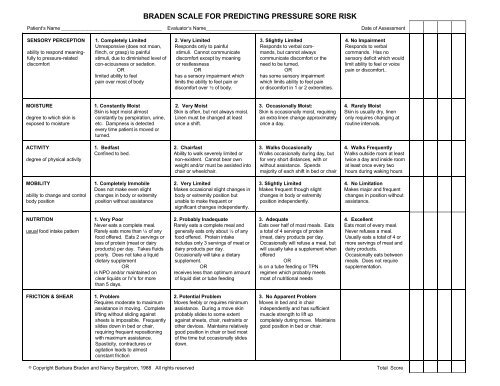Tool and Resource Evaluation Template - Department of Health
Tool and Resource Evaluation Template - Department of Health
Tool and Resource Evaluation Template - Department of Health
Create successful ePaper yourself
Turn your PDF publications into a flip-book with our unique Google optimized e-Paper software.
BRADEN SCALE FOR PREDICTING PRESSURE SORE RISK<br />
Patient=s Name _____________________________________ Evaluator=s Name________________________________ Date <strong>of</strong> Assessment<br />
SENSORY PERCEPTION<br />
ability to respond meaningfully<br />
to pressure-related<br />
discomfort<br />
1. Completely Limited<br />
Unresponsive (does not moan,<br />
flinch, or grasp) to painful<br />
stimuli, due to diminished level <strong>of</strong><br />
con-sciousness or sedation.<br />
OR<br />
limited ability to feel<br />
pain over most <strong>of</strong> body<br />
2. Very Limited<br />
Responds only to painful<br />
stimuli. Cannot communicate<br />
discomfort except by moaning<br />
or restlessness<br />
OR<br />
has a sensory impairment which<br />
limits the ability to feel pain or<br />
discomfort over 2 <strong>of</strong> body.<br />
3. Slightly Limited<br />
Responds to verbal comm<strong>and</strong>s,<br />
but cannot always<br />
communicate discomfort or the<br />
need to be turned.<br />
OR<br />
has some sensory impairment<br />
which limits ability to feel pain<br />
or discomfort in 1 or 2 extremities.<br />
4. No Impairment<br />
Responds to verbal<br />
comm<strong>and</strong>s. Has no<br />
sensory deficit which would<br />
limit ability to feel or voice<br />
pain or discomfort..<br />
MOISTURE<br />
degree to which skin is<br />
exposed to moisture<br />
1. Constantly Moist<br />
Skin is kept moist almost<br />
constantly by perspiration, urine,<br />
etc. Dampness is detected<br />
every time patient is moved or<br />
turned.<br />
2. Very Moist<br />
Skin is <strong>of</strong>ten, but not always moist.<br />
Linen must be changed at least<br />
once a shift.<br />
3. Occasionally Moist:<br />
Skin is occasionally moist, requiring<br />
an extra linen change approximately<br />
once a day.<br />
4. Rarely Moist<br />
Skin is usually dry, linen<br />
only requires changing at<br />
routine intervals.<br />
ACTIVITY<br />
degree <strong>of</strong> physical activity<br />
1. Bedfast<br />
Confined to bed.<br />
2. Chairfast<br />
Ability to walk severely limited or<br />
non-existent. Cannot bear own<br />
weight <strong>and</strong>/or must be assisted into<br />
chair or wheelchair.<br />
3. Walks Occasionally<br />
Walks occasionally during day, but<br />
for very short distances, with or<br />
without assistance. Spends<br />
majority <strong>of</strong> each shift in bed or chair<br />
4. Walks Frequently<br />
Walks outside room at least<br />
twice a day <strong>and</strong> inside room<br />
at least once every two<br />
hours during waking hours<br />
MOBILITY<br />
ability to change <strong>and</strong> control<br />
body position<br />
1. Completely Immobile<br />
Does not make even slight<br />
changes in body or extremity<br />
position without assistance<br />
2. Very Limited<br />
Makes occasional slight changes in<br />
body or extremity position but<br />
unable to make frequent or<br />
significant changes independently.<br />
3. Slightly Limited<br />
Makes frequent though slight<br />
changes in body or extremity<br />
position independently.<br />
4. No Limitation<br />
Makes major <strong>and</strong> frequent<br />
changes in position without<br />
assistance.<br />
NUTRITION<br />
usual food intake pattern<br />
1. Very Poor<br />
Never eats a complete meal.<br />
Rarely eats more than a <strong>of</strong> any<br />
food <strong>of</strong>fered. Eats 2 servings or<br />
less <strong>of</strong> protein (meat or dairy<br />
products) per day. Takes fluids<br />
poorly. Does not take a liquid<br />
dietary supplement<br />
OR<br />
is NPO <strong>and</strong>/or maintained on<br />
clear liquids or IV=s for more<br />
than 5 days.<br />
2. Probably Inadequate<br />
Rarely eats a complete meal <strong>and</strong><br />
generally eats only about 2 <strong>of</strong> any<br />
food <strong>of</strong>fered. Protein intake<br />
includes only 3 servings <strong>of</strong> meat or<br />
dairy products per day.<br />
Occasionally will take a dietary<br />
supplement.<br />
OR<br />
receives less than optimum amount<br />
<strong>of</strong> liquid diet or tube feeding<br />
3. Adequate<br />
Eats over half <strong>of</strong> most meals. Eats<br />
a total <strong>of</strong> 4 servings <strong>of</strong> protein<br />
(meat, dairy products per day.<br />
Occasionally will refuse a meal, but<br />
will usually take a supplement when<br />
<strong>of</strong>fered<br />
OR<br />
is on a tube feeding or TPN<br />
regimen which probably meets<br />
most <strong>of</strong> nutritional needs<br />
4. Excellent<br />
Eats most <strong>of</strong> every meal.<br />
Never refuses a meal.<br />
Usually eats a total <strong>of</strong> 4 or<br />
more servings <strong>of</strong> meat <strong>and</strong><br />
dairy products.<br />
Occasionally eats between<br />
meals. Does not require<br />
supplementation.<br />
FRICTION & SHEAR<br />
1. Problem<br />
Requires moderate to maximum<br />
assistance in moving. Complete<br />
lifting without sliding against<br />
sheets is impossible. Frequently<br />
slides down in bed or chair,<br />
requiring frequent repositioning<br />
with maximum assistance.<br />
Spasticity, contractures or<br />
agitation leads to almost<br />
constant friction<br />
2. Potential Problem<br />
Moves feebly or requires minimum<br />
assistance. During a move skin<br />
probably slides to some extent<br />
against sheets, chair, restraints or<br />
other devices. Maintains relatively<br />
good position in chair or bed most<br />
<strong>of</strong> the time but occasionally slides<br />
down.<br />
3. No Apparent Problem<br />
Moves in bed <strong>and</strong> in chair<br />
independently <strong>and</strong> has sufficient<br />
muscle strength to lift up<br />
completely during move. Maintains<br />
good position in bed or chair.<br />
8 Copyright Barbara Braden <strong>and</strong> Nancy Bergstrom, 1988 All rights reserved Total Score
















